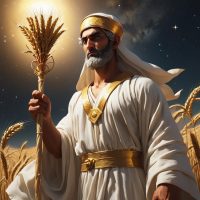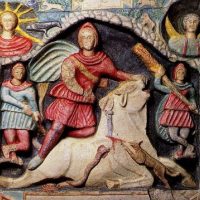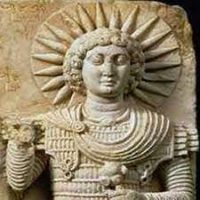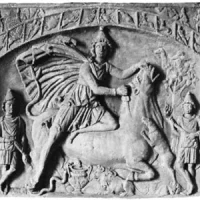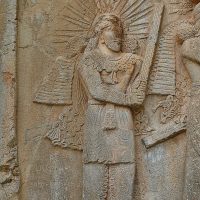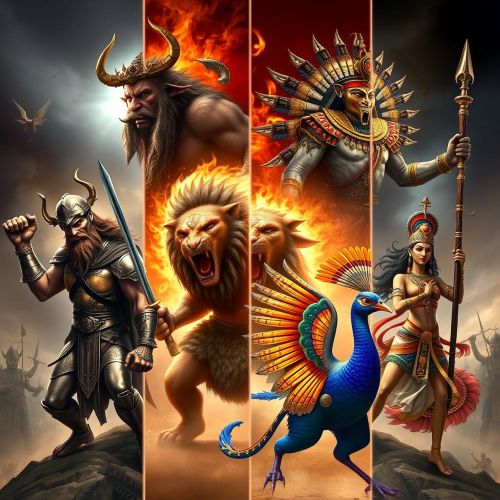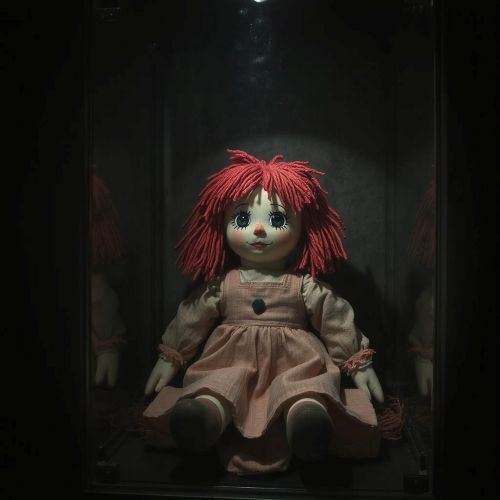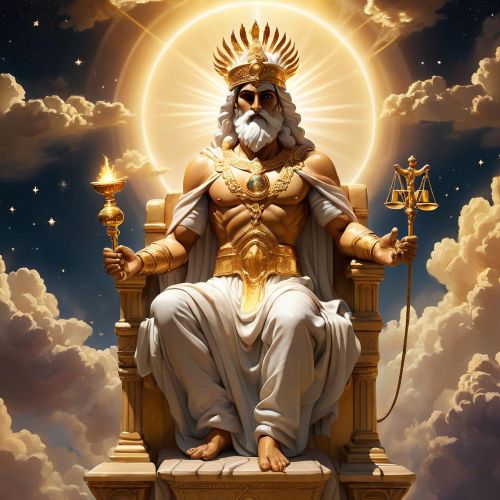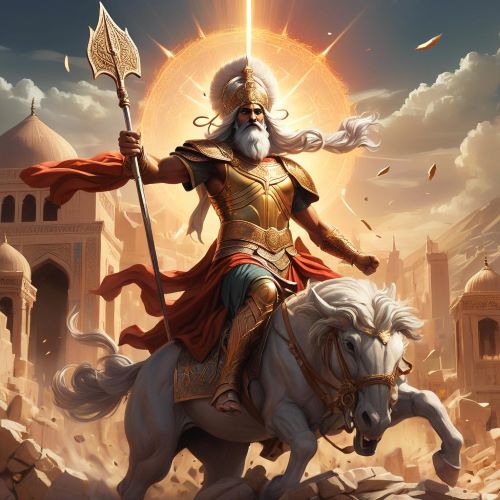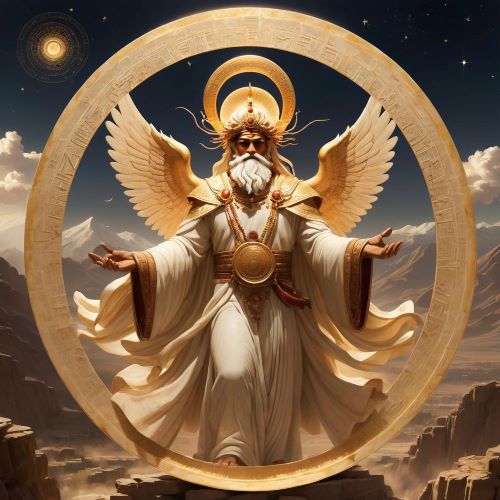Mithra : God of Light
Listen
At a glance
| Description | |
|---|---|
| Origin | Iranian Mythology |
| Classification | Gods |
| Family Members | N/A |
| Region | Iran |
| Associated With | Light, Fertility, Sun |
Mithra
Introduction
Mithra, also recognized as Mehr or Mithras in Roman culture, holds a revered place in ancient Iranian mythology. Revered as a deity of light, justice, contracts, friendship, and cosmic order, Mithra’s influence extends far beyond the boundaries of Iran. Originating in ancient Iran, his worship journeyed westward, leaving an indelible mark on Roman religion through the phenomenon of Mithraism. This expansive reach, spanning from India to the western reaches of Spain, Great Britain, and Germany, underscores Mithra’s profound significance within ancient Indo-Iranian belief systems. As a radiant figure embodying the essence of light and truth, Mithra’s presence illuminates the spiritual and cultural landscape of the region, captivating scholars and enthusiasts throughout the ages.
Physical Traits
While ancient texts provide no explicit description of Mithra’s physical characteristics, artistic representations offer glimpses into his portrayal. In a notable 4th-century Sasanian relief, Mithra emerges as a figure of formidable power. Radiant and adorned in regal attire, he commands an aura of majesty, embodying the brilliance of the sun itself. Central to his depiction is the symbolism of light, highlighting his celestial association with the life-giving rays of the sun.
Though his appearance remains somewhat enigmatic, recurring motifs shed light on his essence. Often depicted as a youthful and vigorous figure, Mithra symbolizes the rising sun and vitality. Notably, in Roman depictions, he is often depicted donning a Phrygian cap, a mark of foreign divinity in Roman culture. Additionally, in Mithraic imagery, he is frequently depicted slaying a bull, symbolizing the eternal struggle between good and evil, and the cyclical nature of existence.
Family
Mithra’s familial lineage remains shrouded in ambiguity within surviving texts. While some scholars suggest a potential association with Ahura Mazda, the paramount deity in Zoroastrianism, conclusive evidence is lacking. References also allude to a charioteer figure, often linked with the Vedic sun god Surya. Positioned within the Iranian ahuric triad alongside Ahura Mazda and Ahura Berezaiti, Mithra assumes a significant role in the Zoroastrian pantheon. This divine trio commands reverence within Iranian mythology, although the precise familial connections of Mithra remain open to interpretation. Whether depicted as a sibling to figures like Anahita or as part of a divine triumvirate with Ahura Mazda and Apam Napat, Mithra’s lineage underscores his elevated status within the celestial hierarchy.
Other names
Mithra’s influence transcends both geographical and cultural boundaries, assuming diverse manifestations across civilizations. In Persian tradition, he is honored as Mithra, symbolizing concepts of light and truth deeply ingrained in the cultural fabric. However, Mithra’s resonance extends far beyond Iran, resonating within other ancient cultures as well. In Roman mythology, Mithras emerges as a revered figure, central to a mystery cult that flourished across the Roman Empire. Known by various names across cultures and epochs, Mithra is called Miθra in Avestan, Miθra in Old Persian, and mihr in Middle Iranian languages, from which derive modern Persian mehr and Armenian mihr/mher. The Achaemenid Persians referred to him as Mithra, while the Romans adopted the name Mithras. Even in contemporary Iran, he continues to be venerated as Mehr. These diverse appellations underscore the widespread influence of this deity, whose name, translating to “contract” or “friendship” in Indo-Iranian tongues, reflects his pivotal role as the guardian of agreements and social harmony.
Powers and Abilities
Mithra, the overseer of sacred contracts and oaths, governs the foundational bonds that shape human relationships, ensuring justice and order prevail. Symbolizing enlightenment and clarity, his association with light guides mortals along the path of moral integrity and spiritual awakening. Revered as the embodiment of the sun’s radiant power, Mithra’s influence extends over domains of fertility, prosperity, and triumph. He embodies an array of divine attributes, including solar dominion, cosmic harmony, justice, warfare, sovereignty, and occasionally fertility and abundance. Through these multifaceted powers, Mithra guides humanity towards prosperity, justice, and spiritual enlightenment.
While ancient Iranian rituals dedicated to Mithra remain elusive, insights into Mithraic practices emerge from Roman Mithraism. These rituals, often shrouded in secrecy, revolved around symbolic gestures such as bull sacrifice, likely serving to strengthen social cohesion, foster allegiance, and align worshippers with Mithra’s cosmic order. Despite waning worship due to Christianity’s ascent in the Roman Empire, Mithra’s legacy persisted, influencing various cultural facets like art, literature, and Christian iconography.
The iconic imagery of a triumphant youth vanquishing a bull found resonance in later depictions of figures like Saint George and the Dragon. In present-day Iran, Mithra’s name, Mehr, endures, reflecting the lasting reverence for this significant deity. Moreover, Mithra remains a subject of scholarly intrigue and fascination for those delving into religious history.
Modern Day Influence
Mithra’s influence extends far beyond ancient epochs, with Romans attributing their Mithraic rites to Zoroastrian Persian origins intertwined with Mithra’s legacy. Throughout the 3rd and 4th centuries AD, Mithraism emerged as Christianity’s primary rival, boasting notable adherents such as Roman emperors Commodus and Julian. The consecration of a temple to Mithra as the “Protector of the Empire” by Diocletian in 307 AD underscored the deity’s centrality in Roman society.
In contemporary life, Mithra’s resonance endures across various domains. The Iranian calendar’s month of Mithra (Mehr) coincides with the autumnal equinox, symbolizing the changing seasons and the cosmic order Mithra upholds. Furthermore, Mithra’s iconic image, depicted slaying the bull, continues to inspire artists and writers, serving as a symbol of triumph over adversity. Moreover, scholars note parallels between Mithraic rituals and the practices of certain clandestine organizations, emphasizing his association with loyalty, fraternity, and esoteric knowledge.
Despite the millennia that have passed, Mithra’s influence persists in modern society. His symbolism permeates cultural and religious spheres, guiding seekers toward existential truths and serving as a focal point for scholarly exploration into ancient belief systems. In essence, Mithra’s timeless virtues and symbolic significance continue to leave an indelible imprint on cultural heritage, transcending the boundaries of myth and legend.
Related Images
Frequently Asked Questions
What is lorem Ipsum?
I am text block. Click edit button to change this text. Lorem ipsum dolor sit amet, consectetur adipiscing elit. Ut elit tellus, luctus nec ullamcorper mattis, pulvinar dapibus leo.
What is lorem Ipsum?
I am text block. Click edit button to change this text. Lorem ipsum dolor sit amet, consectetur adipiscing elit. Ut elit tellus, luctus nec ullamcorper mattis, pulvinar dapibus leo.
What is lorem Ipsum?
I am text block. Click edit button to change this text. Lorem ipsum dolor sit amet, consectetur adipiscing elit. Ut elit tellus, luctus nec ullamcorper mattis, pulvinar dapibus leo.
What is lorem Ipsum?
I am text block. Click edit button to change this text. Lorem ipsum dolor sit amet, consectetur adipiscing elit. Ut elit tellus, luctus nec ullamcorper mattis, pulvinar dapibus leo.
What is lorem Ipsum?
I am text block. Click edit button to change this text. Lorem ipsum dolor sit amet, consectetur adipiscing elit. Ut elit tellus, luctus nec ullamcorper mattis, pulvinar dapibus leo.

